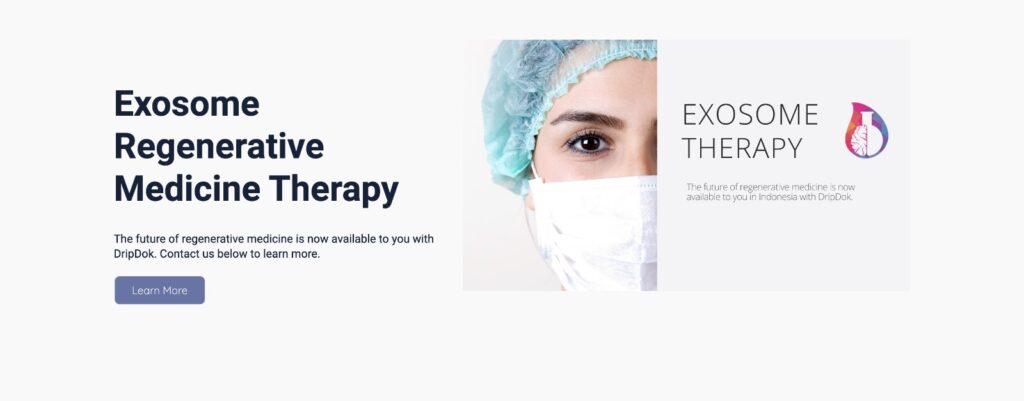In the ever-evolving landscape of regenerative medicine, exosome therapy has emerged as a revolutionary approach to enhancing health and well-being. At Dripdok, our mission is to provide cutting-edge healthcare solutions that empower patients to rejuvenate and optimize their quality of life through innovative treatments like exosomes. In this comprehensive guide, we’ll dive deep into the fascinating world of exosome therapy, exploring its benefits, treatment frequency, factors influencing longevity, and its potential for neurological repair. This guide will serve as your ultimate FAQ for understanding the incredible potential of exosome treatments.

The Multifaceted Benefits of Exosome IV Therapy
Exosome IV Therapy, a realm where science and holistic well-being converge, unveils an array of captivating benefits that span far and wide. It’s not just about bolstering the immune system; it’s about nurturing your body, mind, and spirit. Let’s embark on an exhilarating journey through the layers of exosome IV therapy, exploring its profound potential.
Immune Enhancement: At the core of exosome IV therapy lies the nurturing of the immune system. It’s the shield that guards against immune deficiencies and autoimmune diseases, offering a resolute hand to those in need. Exosome IV infusions stimulate the production of new, resilient cells while shielding the body from the ravages of infections, culminating in an elevated state of immune function and robust health.
MATIX Exosomes: A Pinnacle of Regeneration: In the realm of regenerative therapies, MATIX exosomes stand as a testament to pioneering advancements. They chart a course towards not just rejuvenation but complete regeneration. With a profound potential to foster the growth of new tissues, nurture blood vessels, and ignite neurological regeneration, MATIX exosomes represent a remarkable stride toward comprehensive wellness.
Cognitive Revival: Exosome IV therapy extends its hand to the realm of cognitive well-being. It’s a pathway to sharpened focus, heightened cognitive function, and crystalline clarity of thought. By reversing neurological damage, exosome therapy empowers the mind and enhances brain health.
Immune Resilience: Beyond the foundational support to the immune system, exosome therapy plays a pivotal role in addressing immune-related conditions. It’s the key that unlocks resilience against ailments and paves the way for a healthier, more vibrant life.
Inflammation Alleviation: In the battle against inflammation, exosome IV therapy emerges as a potent ally. It’s a journey toward a body in harmony, where inflammation takes a backseat, and wellness takes the forefront.
Tissue Regeneration: The power to regenerate is woven into the fabric of exosome therapy. It’s a journey into the world of tissue regeneration, where injured or aging tissues find the vigor to renew and revitalize.
Chronic Pain Management: Chronic pain can be a relentless burden, but exosome therapy brings relief. It’s a testament to the art of managing and reducing chronic pain, offering solace to those seeking respite.
The Elixir of Youth: The pursuit of youthfulness transcends conventional boundaries with exosome IV therapy. It’s the elixir that defies time, turning back its relentless march. The therapy contributes to anti-aging effects, offering a glimpse into the fountain of youth.
Wound Healing Mastery: Healing is a profound art, and exosome therapy is its masterstroke. It’s a journey into the world of efficient wound healing, where injuries find swifter resolution and scars bear the story of resilience.
Our voyage through the multifaceted benefits of exosome IV therapy is but a beginning, an introduction to a realm where science, well-being, and human potential converge. This therapy is not just a treatment; it’s a holistic approach to life. Join us as we navigate the depths of its potential, exploring how it can be your gateway to enhanced health and wellness.
Also Read : Unveiling The Big Power Of Hyperbaric Oxygen Therapy (HBOT)
How often can you do exosomes?
Individual responses differ, which in turn determines the number of exosome treatments required to see significant results depending on the condition. A minimum of three and a maximum of five sessions, 2 weeks apart are recommended for maximum impact.
One treatment session can be very beneficial if used in conjunction with another treatment and a healthy lifestyle. At Dripdok we use a proprietary infusion with NAD+, NMN, Glutathione, and Cerebrolysin to maximize single IV treatments and work with expectations depending on the client’s current health status.

How Long Do Exosome Treatments Last?
Exosome treatments are a fascinating expedition into the world of regenerative medicine, and their duration is a puzzle with pieces that vary from person to person. Comparing the longevity of exosome treatments to the lifespan of a car wash might seem unusual, yet the analogy is apt. Just as a car wash’s effects can be influenced by factors like weather and usage, exosome treatments are also subject to a web of influences.
The journey of exosome treatments typically begins with patients noticing noticeable improvements in their skin’s appearance over several months. It’s akin to seeing a car gleaming after a thorough wash. On average, these results can endure for a substantial six to eight months, offering a rejuvenated and refreshed feeling.
However, the story doesn’t end there.
Much like the internal mechanics of a car that need careful maintenance, the regenerative effects of exosome treatments should not be underestimated. They play a pivotal role in influencing the treatment’s duration, leaving an indelible mark on the journey.
In this guide, we’ll embark on an exploration of the various factors that weave the fabric of exosome treatment longevity. From the extent of preexisting damage to ongoing stress on the body, and the very efficacy of the treatment itself, we will dissect the key elements that shape the lifespan of exosome treatments.
Moreover, our journey will guide you on how to ensure that the benefits of exosome treatments are not short-lived. Just as taking your car for regular maintenance can prolong its lifespan, certain practices and follow-up actions can help patients unlock the secret to the longest-lasting benefits of exosome treatments.
What factors influence how long exosome treatments last?
Several factors come into play, The extent of preexisting damage If there’s minimal damage, the benefits may last longer. Ongoing damage If the body continues to experience damage or wear and tear, it can impact how long the benefits last. The efficacy of the treatment The degree to which the treatment addressed the issue can affect its longevity. Can you provide examples to illustrate this?
Certainly! For instance, a person with mild joint discomfort who undergoes exosome treatment may experience long-lasting relief. However, someone with severe joint damage and ongoing stress on the joint may find that the improvement is not permanent.
Is there a way to make the effects of exosome treatments last longer? Yes, there is a possibility. Just like ensuring your car stays clean, some patients opt for repeat exosome treatments. By doing so, they aim to maintain or even enhance the benefits and potentially extend the duration of improvement. Maintaining sleep, positive healthy relationships, fitness, a clean diet, and low inflammation are the key players here. We offer pre and post-exosome protocols to extend the life of the treatment.

The Placebo Effect, Is There One With Exosomes?
In recent clinical encounters, we’ve encountered several instances that challenge the conventional notion of the placebo effect in the context of regenerative therapies involving exosomes. In these cases, patients, such as Mr. Smith, a 65-year-old surfer, scoring a biological age of 26 after Exosomes and NAD+, and a recent 27-year-old patient, have reported remarkable improvements in various medical conditions following exosome treatments.
For Mr. Smith (name changed), an individual with no preconceived notions, the improvement of complexion, hair, skin, and nails – alongside joint clicking, a condition he had long forgotten even though it was related to a skiing injury from years ago, was notable. Additionally, he experienced pain relief and alleviation of cramps in his latissimus dorsi muscles.
Likewise, our recent 61-year-old patient, who claimed not to be particularly susceptible to the placebo effect, noted several positive changes. These included the resolution of pain related to an old whiplash injury, enhanced sleep quality, and a reduction in symptoms associated with plantar fasciitis, back pain, shoulder pain, and knee pain. The patient underwent treatment involving the administration of 5 vials (5-10 Trillion Exosomes) delivered through IV (although we can do it through specialized injections around the area, combined with PRP for even better results in joint pain.
It’s important to emphasize that the quantity and precise location of exosome administration appear to be significant factors in achieving favorable outcomes.
As clinical experience continues to accumulate, we are increasingly appreciating the remarkable and wide-ranging effects that exosomes can exert. In the case of Ms. Johnson’s 55-year-old father, who recently received 3 trillion IV exosomes for neuropathy and reported improvement, the possibility of a placebo effect cannot be entirely dismissed. However, it is equally plausible that the observed improvements stem from the intricate biological signals generated by newborn placental membranes (according to FDA guidelines for extraction) with 1,600 growth factors as they interact with our damaged cells and the underlying inflammatory processes.
In matters where the placebo effect is less likely to play a role, such as voluntary piloerection, taste aversions, or the resolution of chronic eczema associated with venous stasis, it is increasingly apparent that profound physiological changes are at play. While we understand the human desire for the belief that placebo effects can address a wide array of health concerns, it’s important to recognize that faith healing ultimately emerges from tangible, measurable results and the genuine desire to restore youthfulness and health.
One of the cornerstones of effective healthcare and personalized treatment plans is the availability of baseline data. This data serves as a critical reference point that allows healthcare providers to assess a patient’s current health status, track changes over time, and make informed decisions regarding their care. This principle is particularly significant when considering regenerative therapies like exosome treatments, where the effects can be profound yet subtle and subjective.
Baseline Data The Foundation of Informed Treatment
Entering into treatment, especially one involving innovative therapies like exosomes, with baseline data is akin to having a starting point on a map before embarking on a journey. This data can take various forms, with blood work being a traditional and essential component. Blood tests can reveal a wealth of information, including biochemical markers, hormone levels, inflammatory markers, and much more. They provide insights into the patient’s internal health, serving as a diagnostic tool and a reference point for assessing the impact of treatment.
Moreover, health metrics gathered from wearable devices such as the Oura Ring, Apple Watch, or Fitbit have become increasingly valuable in modern healthcare. These devices provide continuous data on various health parameters, including heart rate, sleep patterns, activity levels, and more. Wearable technology has ushered in an era of real-time health monitoring, allowing individuals and healthcare providers to track changes and trends in health metrics over time.
The Power of Quantification
The key advantage of entering treatment armed with baseline data and health metrics is quantification. Quantification allows us to move beyond relying solely on subjective feelings, which can be highly variable and influenced by numerous factors, to establish a more objective and data-driven approach to healthcare.
Consider, for instance, a patient who undergoes exosome therapy with the primary goal of reducing chronic pain. If baseline data, including pain scores and activity levels, are collected before treatment and then monitored consistently throughout the therapy, quantifiable improvements can be measured. Pain scores can be tracked, and activity levels can be objectively assessed. This not only provides the patient with tangible evidence of progress but also empowers healthcare providers to make informed adjustments to the treatment plan as needed.
The Holistic Picture of Health
Furthermore, the use of wearable health technology allows for a more quantifiable view of an individual’s health. It takes into account not only specific symptoms or conditions but also factors like sleep quality, stress levels, heart rate variability, and activity patterns. These metrics contribute to a comprehensive understanding of a patient’s well-being and can uncover connections and correlations that may otherwise go unnoticed.
In conclusion, baseline data and health metrics obtained from sources such as blood work and wearable devices are invaluable tools in modern healthcare, especially when exploring innovative treatments like exosome therapy. They provide a foundation of objective information, enabling quantification of health improvements and a more comprehensive view of overall well-being. This data-driven approach not only enhances the patient’s experience but also equips healthcare providers with the insights needed to optimize treatment plans and outcomes. In a world where health is increasingly personalized and data-centric, embracing this approach is a significant step toward achieving the best possible results in regenerative medicine and beyond.
People would like to believe that feelings can be the ultimate gauge of health but we can only get so far without the help of data.
What Type Of Neurological Factors Are Repaired?
The direct injection of the MATRIX exosomes via IV seems to have a profound effect on the prefrontal cortex which holds promise for facilitating processes like remyelination and neuronal regeneration. These therapeutic effects may be attributed to the presence of specific agents within exosomes, such as BDNF (brain-derived neurotrophic factor) and GDNF (glial-derived neurotrophic factor).
In summary, there have been moments when I questioned the effectiveness of exosome treatments, particularly when a single round did not entirely resolve a patient’s condition. However, I’ve come to realize that expecting a higher dose to guarantee a complete cure is not always the solution. Moreover, when it comes to conditions lacking any other viable treatment options, exosomes often represent the most promising path to improvement.
Consider, for instance, a patient who experiences an 80% improvement in a condition that has hitherto been deemed incurable. While a second treatment session may be necessary for full resolution, this substantial level of progress is a remarkable value proposition. The patient’s newfound hope and willingness to pursue additional treatment underscore the transformative potential of exosome therapy.
Practicing medicine in a manner that can genuinely repair and enhance critical brain functions, like those of the prefrontal cortex, rather than merely managing symptoms, is both a joy and a privilege. It reflects our commitment to harnessing innovative medical approaches to empower patients and improve their quality of life.
With multiple MMSE administered we have seen remarkable improvement with early-stage cognitive decline, early-stage Alzheimer and dementia – although to say the complete resolution is impossible however being able to recall names or get out of a wheelchair is significant.
What are recall bias and attribution bias, and why is it important?
A Recall bias refers to the tendency to remember past events or experiences inaccurately, often influenced by current feelings or perceptions. It’s essential because it can affect how we judge the effectiveness of a treatment or therapy.
Attribution bias is the inclination to attribute changes or outcomes to a specific cause, even when there might be other factors at play. It’s closely related to recall bias because our memory can lead us to attribute changes incorrectly based on our current perspective.
Can you give examples of how these biases can impact patient satisfaction with clinical treatments?
Sure, here are a couple of examples…
Example 1 A person with face blindness (prosopagnosia) may not immediately recognize the benefits of treatment because they’re comparing their current state to how they were affected before treatment. Over time, they may realize improvements.
Example 2 A patient may not attribute improvements to a treatment because they expect the benefits to occur naturally. For instance, someone regaining the ability to sleep on their side after a shoulder injury might not credit the treatment, thinking it would have happened anyway.
Why do people tend to compare everything to how they felt when they were young? Many people mentally compare their current state to their youth because they often feel younger than their actual age. This can influence how they perceive and judge the effects of treatments.
Conclusion: Your Journey to Wellness with Exosomes
In the journey of life, health, and well-being, exosome treatments represent a remarkable path to rejuvenation, healing, and optimization. As we conclude this comprehensive guide, we emphasize the transformative potential of exosome therapy in enhancing the quality of life. Dripdok is committed to harnessing the power of exosomes and other innovative medical approaches to empower patients in their pursuit of youthful and healthy living. Whether you’re seeking to understand the longevity of exosome treatments, exploring their
Neurological benefits, or addressing biases that influence perception, this guide provides the knowledge and insights to embark on your wellness journey. Discover the incredible potential of exosomes and unlock the potential of regenerative medicine.

